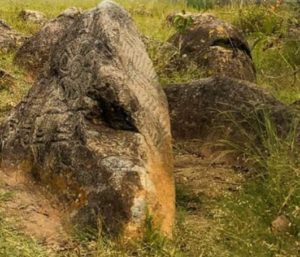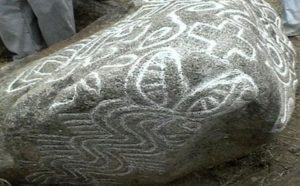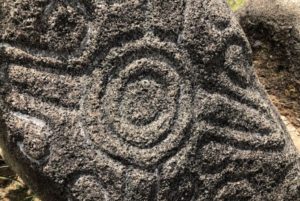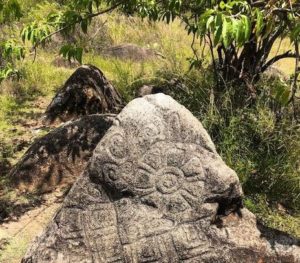Podcast: Play in new window | Download
Subscribe: Apple Podcasts | RSS
 In an arid landscape reminiscent of West Texas or other parts of the American Southwest, three carved monoliths have stood the test of time. These three stones stand guard in the hills outside the Oaxacan town of Santo Tomás Jalieza. Previously only known to locals and handfuls of outsiders guided to the area, the town council of Santo Tomás decided to invite archaeologists from Mexico’s National Institute of Anthropology and History – or INAH – to come to the area to do a survey and to possibly open up the surrounding region to tourism. On July 5, 2014 INAH researchers Cira Martínez López, Robert Markens and Marcus Winter, began exploring the area with the full support of the municipal president Claudio Gómez Jiménez and the townsfolk of Santo Tomás Jalieza. The archaeological survey encompassed several hills and their surroundings including Cerro Danilín, Cerro Yabeo, Cerro Chilaza, Cerro Guialez and Cerro Yaguín. The latter hill is home to the three soon-to-be famous monoliths and in the Zapotec language the word yaguín means “Duck on the Water.” The INAH team discovered many things unknown before, even to the locals, including platforms of ancient structures, inaccessible canyon walls with petroglyphs of human hands, and parts of the landscape littered with pieces of ceramics and fragments of stone tools. Among the curious landmarks in the survey was a rock about 90 feet across called “La Peña Redonda” which forms part of a rock shelter full of artifacts and cave paintings. The researchers also noted in their discoveries a large triangular-shaped conglomerate rock known locally as “La Piedra de Colores” or “La Piedra Hechicera.” The locals nicknamed this the “Guardian Stone” and whenever a traveler passes it, they must ask permission of the stone to go by it. An ancient legend claims the guardian stone was once alive and possessed a consciousness and therefore a traveler must petition the good graces of the stone to tread on its territory. In this place, some 20 miles south of the bustling capital of Oaxaca City, the many legends and visible remains of the past date back thousands of years.
In an arid landscape reminiscent of West Texas or other parts of the American Southwest, three carved monoliths have stood the test of time. These three stones stand guard in the hills outside the Oaxacan town of Santo Tomás Jalieza. Previously only known to locals and handfuls of outsiders guided to the area, the town council of Santo Tomás decided to invite archaeologists from Mexico’s National Institute of Anthropology and History – or INAH – to come to the area to do a survey and to possibly open up the surrounding region to tourism. On July 5, 2014 INAH researchers Cira Martínez López, Robert Markens and Marcus Winter, began exploring the area with the full support of the municipal president Claudio Gómez Jiménez and the townsfolk of Santo Tomás Jalieza. The archaeological survey encompassed several hills and their surroundings including Cerro Danilín, Cerro Yabeo, Cerro Chilaza, Cerro Guialez and Cerro Yaguín. The latter hill is home to the three soon-to-be famous monoliths and in the Zapotec language the word yaguín means “Duck on the Water.” The INAH team discovered many things unknown before, even to the locals, including platforms of ancient structures, inaccessible canyon walls with petroglyphs of human hands, and parts of the landscape littered with pieces of ceramics and fragments of stone tools. Among the curious landmarks in the survey was a rock about 90 feet across called “La Peña Redonda” which forms part of a rock shelter full of artifacts and cave paintings. The researchers also noted in their discoveries a large triangular-shaped conglomerate rock known locally as “La Piedra de Colores” or “La Piedra Hechicera.” The locals nicknamed this the “Guardian Stone” and whenever a traveler passes it, they must ask permission of the stone to go by it. An ancient legend claims the guardian stone was once alive and possessed a consciousness and therefore a traveler must petition the good graces of the stone to tread on its territory. In this place, some 20 miles south of the bustling capital of Oaxaca City, the many legends and visible remains of the past date back thousands of years.
Santo Tomás Jalieza and the surrounding area form the southern part of what is now known as the Valles Centrales, or “Central Valleys” of Oaxaca. In the early centuries BC the Zapotecs dominated the region and grew in power, governing from the now-ruined mountaintop stronghold of Monte Albán, one of the most populous cities in ancient Mexico at the time. Although the Zapotecs remained culturally dominant in the region, by the year 1000 AD or so, the area fell under the control of the Mixtec Empire, ruling from their capital city of Tilontongo some 75 miles northwest of Santo Tomás Jalieza. Under the rule of Emperor Ahuitzotl in the late 1490s, the area fell under Aztec domination, until the Europeans came a few decades later. Throughout the various change in rulers, the Zapotecs never left the area and their culture persisted through the Spanish Conquest and into modern times.
 When the Spanish arrived, they observed the indigenous people of the area surrounding modern-day Santo Tomás Jalieza performing various rituals in the Cerro Yaguín around the time of the winter solstice, December 21. Hundreds of people from many miles away made the pilgrimage to the low hill where the three monoliths still stand. Because two springs are born near the area of the monoliths, the Spanish believed that the natives were practicing rites to honor the water gods or engaging in ceremonies connected with fertility and rebirth. Because they sought to convert the natives to Christianity more easily, church officials picked a saint for the locals to venerate whose feast day corresponded with their winter solstice pilgrimages and festivities. On the Catholic calendar Saint Thomas the Apostle’s feast day fell on December 21, so the Spanish renamed the local indigenous village Santo Tomás in honor of the apostle. The solstice ceremonies were taken out of the countryside and brought into the village and its newly built church and church fathers altered the festivities somewhat to be more “Christian.” The indigenous people still had a celebration on the day that had been sacred to them since time immemorial, it was just changed to please the new masters. Even though the great indigenous winter celebration fell out of favor, the locals still visited the hill of the monoliths and to this day the people of Santo Tomás Jalieza revere the area as a sacred and mystical place.
When the Spanish arrived, they observed the indigenous people of the area surrounding modern-day Santo Tomás Jalieza performing various rituals in the Cerro Yaguín around the time of the winter solstice, December 21. Hundreds of people from many miles away made the pilgrimage to the low hill where the three monoliths still stand. Because two springs are born near the area of the monoliths, the Spanish believed that the natives were practicing rites to honor the water gods or engaging in ceremonies connected with fertility and rebirth. Because they sought to convert the natives to Christianity more easily, church officials picked a saint for the locals to venerate whose feast day corresponded with their winter solstice pilgrimages and festivities. On the Catholic calendar Saint Thomas the Apostle’s feast day fell on December 21, so the Spanish renamed the local indigenous village Santo Tomás in honor of the apostle. The solstice ceremonies were taken out of the countryside and brought into the village and its newly built church and church fathers altered the festivities somewhat to be more “Christian.” The indigenous people still had a celebration on the day that had been sacred to them since time immemorial, it was just changed to please the new masters. Even though the great indigenous winter celebration fell out of favor, the locals still visited the hill of the monoliths and to this day the people of Santo Tomás Jalieza revere the area as a sacred and mystical place.
So, what do these monoliths look like? They are basically three large upright boulders made of volcanic rocks with carvings on them. While some of the markings on the monoliths are now faint, one of the stones in particular the locals have re-carved and enhanced the carved lines with white paint. This fresh appearance has led some researchers to believe that this rock, along with the others, are modern fakes made by some people in the town of Santo Tomás Jalieza to bring tourists to the area. The research team from the National Museum of Anthropology and History out of Mexico City would disagree. One of the monoliths, nicknamed “El Pie del Rayo,” or in English, “The Foot of Lightening,” has an image of a foot on it that archaeologists have identified with a culture that predates the Zapotecs by thousands of years. The second monolith, called “Jaguar Rock” has carvings related to kingship symbolism which date to the height of the Zapotec Empire in the early centuries AD. Many of the images on all three monoliths are stylistically similar to pictographs and artwork made during the beginnings of Zapotec civilization and are assumed to date to around 500 BC. Whatever the exact date of these carvings, this area has been a sacred place for a very long time.
 The monolith that has gotten the greatest amount of attention from researchers and other visitors is the “Piedra de la Letra,” or, in English, “The Stone of the Letters.” This large rock is shaped like a cone or an irregular pyramid with three surfaces or worked faces. On one side the image of a Zapotec sun dominates the surface. On another side a plumed serpent creature raises its head to the top of the stone. Both the sun and the serpent look as if they are reaching for a cross which is painted on the apex of the monolith. The locals and the archaeologists agree that the cross represents the universe in the form of the four cardinal directions, and the sun versus the plumed serpent symbolizes the eternal battle of good against evil. On the third face of the Piedra de la Letra is a beautiful depiction of a flower. This is thought to represent the birth of a new age after good wins in its battle with evil for control of the universe. Locals are also quick to point out that the monoliths, together with other stones on the Cerro Yaguín are arranged in such a way to serve as a terrestrial map of the constellations Orion and Canis Major, which includes the brightest star in the sky, Sirius.
The monolith that has gotten the greatest amount of attention from researchers and other visitors is the “Piedra de la Letra,” or, in English, “The Stone of the Letters.” This large rock is shaped like a cone or an irregular pyramid with three surfaces or worked faces. On one side the image of a Zapotec sun dominates the surface. On another side a plumed serpent creature raises its head to the top of the stone. Both the sun and the serpent look as if they are reaching for a cross which is painted on the apex of the monolith. The locals and the archaeologists agree that the cross represents the universe in the form of the four cardinal directions, and the sun versus the plumed serpent symbolizes the eternal battle of good against evil. On the third face of the Piedra de la Letra is a beautiful depiction of a flower. This is thought to represent the birth of a new age after good wins in its battle with evil for control of the universe. Locals are also quick to point out that the monoliths, together with other stones on the Cerro Yaguín are arranged in such a way to serve as a terrestrial map of the constellations Orion and Canis Major, which includes the brightest star in the sky, Sirius.
The people of Santo Tomás Jalieza have long treated the area around the monoliths with a mix of respect and caution. Outsiders are only allowed in the area if accompanied by two indigenous elders along with their guide. The elders will get a “feeling” near the monoliths and will sense whether it is okay for the visitor to take pictures or video. If the elders sense that the area itself is giving them permission to do so, the visitors may take out their modern technology, whether phone or camera, and take photos or film. In January 2020, a film crew from Mexico City making a documentary on the region of Santo Tomás Jalieza sent up a drone to film a bird’s eye view of the surrounding area. The city folk did not ask the proper permission to do this. The drone mysteriously crashed and was destroyed beyond repair.
 A local legend tells of a woman in historical times wandering up to the Cerro Yaguín and disappearing for a few days. This woman returned to town to tell a strange story of slipping into another dimension where she was in the middle of a gigantic pre-Hispanic indigenous market. The head of the market even offered her a job and asked her to stay but she declined and returned to her normal place and time after a brief fainting spell. Some believe that the place of the monoliths is an area where the so called “veil” between space and time is thin and one can slip in and out of different dimensions and times there. Another local legend goes one step beyond and claims that underneath each monolith is a portal to another world. The National Institute of Anthropology and History has no plans to undertake any excavations underneath the monoliths, at least not presently.
A local legend tells of a woman in historical times wandering up to the Cerro Yaguín and disappearing for a few days. This woman returned to town to tell a strange story of slipping into another dimension where she was in the middle of a gigantic pre-Hispanic indigenous market. The head of the market even offered her a job and asked her to stay but she declined and returned to her normal place and time after a brief fainting spell. Some believe that the place of the monoliths is an area where the so called “veil” between space and time is thin and one can slip in and out of different dimensions and times there. Another local legend goes one step beyond and claims that underneath each monolith is a portal to another world. The National Institute of Anthropology and History has no plans to undertake any excavations underneath the monoliths, at least not presently.
Along with the beliefs of interdimensional portals come stories of UFO sightings and encounters with extraterrestrial beings on the Cerro Yaguín. Tales of flying saucers and aliens are usually dismissed by the locals and are credited to the overactive imaginations and wishful thinking of outsiders.
Only recently disclosed to the outside world, the Monoliths of Santo Tomás Jalieza, Oaxaca are the source of many mysteries and much wonder. With more study and analysis will these timeless stones ultimately reveal their deepest secrets?
REFERENCES
INAH Web site
Vive Oaxaca web site (in Spanish) https://www.viveoaxaca.org/2016/01/MonolitosJalieza.html
